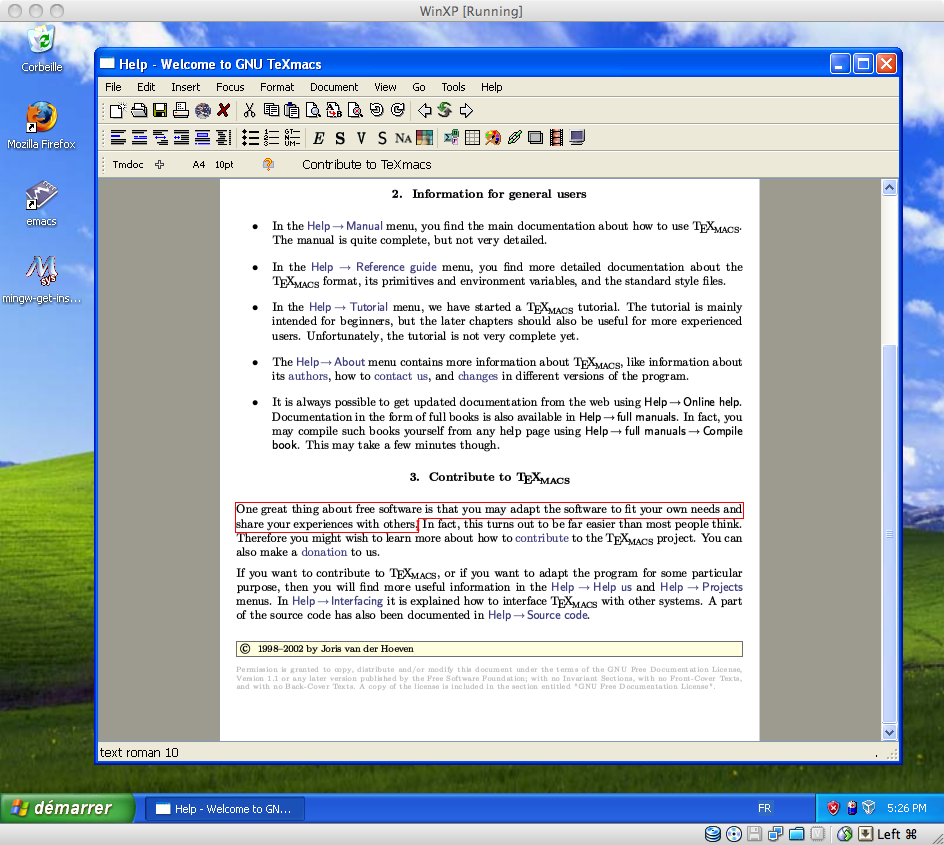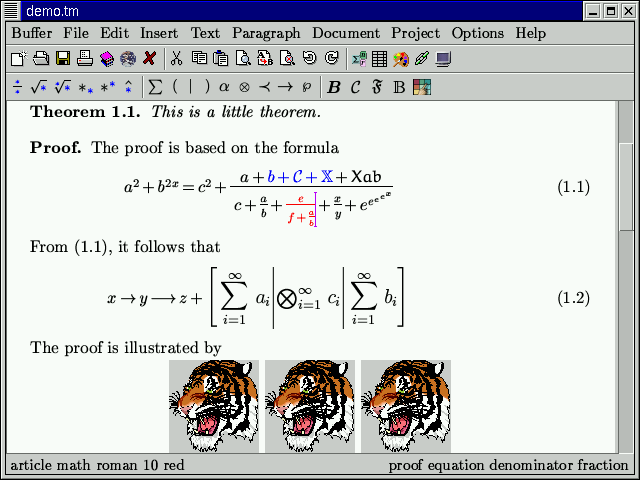

> because 1 pixel is no longer 1 pixel on a retina screen (some kind of > It rather seems to on the Qt/X11 side that there is a problem, > So there is no real obstacle on our side. > of the new set of TeXmacs icons, which one should use in this case). > and arbitrary size icons (by the way, I just committed the SVG versions > In principle, TeXmacs is able to work with fonts at higher resolution, > except that no advantage is taken out of the higher resolution. > Yes, Ingolf/Max are right in the sense that TeXmacs works "fine", > properly so I'm very much interested in improving it in that direction. > I currently cannot use my retina laptop since texmacs does not work > it should be possible to convince qt to put them onscreen in the right > help me in obtaining that texmacs produce screen fonts at that resolution T e X macs can also be used as an interface for computer algebra systems. Like emacs, this allows you for instance to redefine keyboard and menu actions. T e X macs comes with a typed lisp extension language. > display where resolution is more or less 144 dpi instead of 72 so if Jpris In particular, the text you see on the screen corresponds exactly to what you get after printing.
#SCREENS TEXMACS HOW TO#
> double screen resolution and I was not able to understand how to do this. > my machine) the real issue is that we have to provide bitmapped fonts at > as far as I understand the qt port ready works fine under retina (checked > On Tue, at 12:07:35AM +0100, Gubinelli Massimiliano wrote: 2012, at 09:28, Joris van der Hoeven wrote: > tweak texmacs to have double resolution bitmaps for tge glyphs but didn't > fonts should be able to convince Qt to show them properly. If you explain to me how to have 144 dpi bitmaps for the As for bitmaps i think we just need to provide qt with high > yes, vector operations on the graphic device are automatically scaled at the On Tue, at 11:37:49AM +0100, Gubinelli Massimiliano wrote: Or should I provide double resolution PNGs? -Joris What about the icons by the way? Can you manage with the SVG sources, All rights reserved.Re: TeXmacs on retina screens texmacs-dev This study helped us identify the freezing responses of different human PBMC subsets using combinations of osmolytes.ĭMSO-free cryoprotectant T cells cryopreservation peripheral blood mononuclear cell.Ĭopyright © 2020 International Society for Cell and Gene Therapy. Immediately post-thaw, both cell types had >30% of cells in early apoptosis, but after 24 h the number of cells in early apoptosis decreased to below 20%. Helper T cell viability dropped 17%, and cytotoxic T cells had a 10% drop in viability.

Both cell types showed a decrease in cell viability 24 h post-thaw compared with immediately post-thaw. Because post-thaw apoptosis is a significant concern for lymphocytes, apoptosis of helper T cell and cytotoxic T cells frozen in a DMSO-free cryoprotectant was analyzed immediately post-thaw and 24 h post-thaw. PBMCs were cultured for 72 h post-thaw to determine the stability of the cells. The statistical model indicated that the preferred concentration levels of osmolytes and interaction modes were distinct between the three subsets studied. Statistical models were used to analyze the importance of individual osmolytes and interactions between post-thaw recoveries of three subsets of T cell including helper T cells, cytotoxic T cells and natural killer T cells. Significant differences between the post-thaw recovery for helper T cells and cytotoxic T cells were observed. The phenotypes and viabilities of PBMC subsets were characterized using flow cytometry. The screening of various formulations using a differential evolution algorithm showed post-thaw recoveries greater than 80% for the two subsets of T cells. This study examined the freezing responses of peripheral blood mononuclear cells (PBMCs) and specific white blood cell subsets contained therein when cryopreserved in three combinations of osmolytes composed of sugars, sugar alcohols and amino acids.Ī differential evolution algorithm with multiple objectives was used to optimize cryoprotectant composition and thus the post-thaw recoveries for both helper and cytotoxicity T cells simultaneously.


 0 kommentar(er)
0 kommentar(er)
